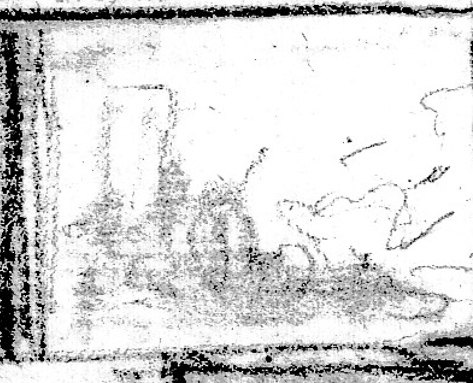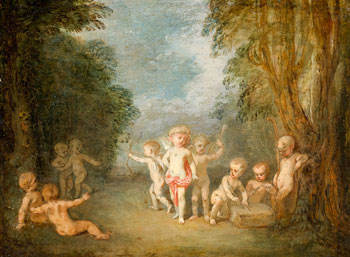
- Home Page
- Accepted
Paintings & Copies - Doubtful
Attributions - Doubtful Textual References
- Alternative
Titles - Collectors &
Museums - Bibliography
- Search Abecedario
- Watteau &
His Circle
X. Soldats près d’une tour
Entered August 2015

Whereabouts unknown
Oil on panel
15.9 x 20.3 cm
ALTERNATE TITLES
Un départ de troupes
PROVENANCE
(?) Paris, collection of Berthélemy Augustin Blondel d’Azincourt (1719-1794; general treasurer of the Caisse des amortissements, supervisor of the Menus-plaisirs du Roi). His sale, Paris April 18ff, 1770, lot 24: “Un départ de troupes, peint sur bois par Jean-Baptiste Pater; hauteur 6 pouces 3 lignes, largeur 8 pouces. Ce tableau est d’un grand mérite; on ne peut recontrer un plus précieux morceau de ce Maître.” It sold for 90 livres to a M. Le Prieur, according to an annotated catalogue in the Rijksbureau voor Kunsthistorische Documentatie.
Paris, collection of Louis François de Bourbon, prince de Conti (1717-1776). His sale, Paris, April 8-June 6, 1777, lot 666: “[Antoine Watteau.] Deux autres bons tableaux sur bois, chacun de 5 pouces de haut sur 6 pouces de large; dans l’un on voit des Amours qui aiguisent leur fleches pour tirer sur un coeur ; dans l’autre des soldats sont près d’une tour.” According to an annotated catalogue in the Bibliothèque nationale, the lot sold for 251 livres to Léraut, L’heraud, or Lerau, depending on which of the several annotated copies of the catalogue that have come down to us. (Adhémar incorrectly reported that the buyer was “Cheraud.”) Léraut was supposedly an “ingénieur” who bought heavily at the sale.
SELECT BIBLIOGRAPHY
Ingersoll-Smouse, Pater (1928), cat. 465.
REMARKS

Gabriel de Saint Aubin, Sketch of the Soldats près d’une tour in the 1777 auction of the prince de Conti‘s collection. Paris, Bibliothèque nationale, Cabinet des estampes.

Watteau, L’Amour aiguisant ses traits, 13.5 x 17.7 cm, oil on panel. USA, private collection.
When this painting was sold in 1777 from the collection of the prince de Conti, it was presented as a work by Watteau and as the pendant to L’Amour aiguisant ses traits. Gabriel de Saint Aubin saw and sketched this military subject in his copy of the catalogue. As small and as rapid as the sketch may be, it allows one to distinguish the major lines of the composition, including the tall tower to the left, and various standing and sitting soldiers. This is the only visual evidence we have about the painting.
Several issues surround this picture, a work that has not been included in the Watteau literature. The first is whether this painting was actually by Watteau and, secondly, whether it was a true pendant to L’Amour aiguisant ses traits. The two issues are inter-related. Its status as a pendant is key to the problem. Thematically and compositionally, this military painting has nothing in common with Watteau’s L’Amour aiguisant ses traits. A small military scene is not well-suited to be paired with a depiction of playful cupids. Likewise, the scale of the figures in the two are quite different: the Soldats près d’une tour has much smaller figures. As will be shown, there is even a question as to whether the two pictures were exactly the same size.
Seven years earlier, in 1770, when L’Amour aiguisant ses traits was sold from the collection of Blondel d’Azincourt, it appeared alone but the immediately following lot was a military subject by Pater. Like the Watteau, it was on panel and it measured only two pouces more in each direction. While not announced as such, the two may have been hung as pendants in d’Azincourt’s collection. Although the two pictures reputedly went to two different buyers, the Watteau going to the dealer Lebrun and the Pater supposedly to someone named Le Prieur, they may have stayed together or been reunited. One can well wonder if they were not the same pendants which reappeared in the prince de Conti’s collection. Such sleights of hand were not uncommon in the marketplace. If not, it means that in the intervening seven years someone scoured the Paris art market to find a pendant for L’Amour aiguisant ses traits and, by chance, came up with a second military subject on panel of approximately the same size. This second scenario seems improbable. But if the 1770 and 1777 military paintings are one and the same, it means that the second time around the attribution to Pater as well as the slight differences in measurements were suppressed. This seems more probable and, if so, then the Soldats près d’une tour does not belong in Watteau’s oeuvre. It should be entered in Pater’s.